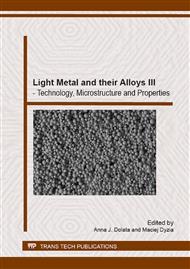p.3
p.9
p.15
p.23
p.31
p.39
p.47
p.53
Proeutectic Crystallisation of AlSi17Cu5 Alloy after Overheating and Modification with Al-CuP Master Alloy
Abstract:
The influence of strong overheating above Tliq. and modification with phosphorus in the form of CuP master alloy on the crystallisation process of AlSi17Cu5 alloy has been discussed. The study shows that with overheating of an alloy from the 3XX.X series above the melting point Tliq. (about 250÷300°C), the β phase undergoes practically complete dissolution. Then, in the liquid metal, areas with high variations in the content of the dissolved silicon appear. These are numerous microregions enriched with dissolved silicon, in which, due to overheating, partial formation of homogeneous nuclei takes place. This process is further enhanced with the use of a modifier (phosphorus) and, as a consequence of the modification process, additional "substrates" (AlP) arise in molten metal to serve as sites for the heterogeneous nucleation of primary Si crystals. In the vicinity of these microregions, some other sites with lower silicon content are formed, in which the proeutectic crystallisation of α (Al, Me) dendrites takes place. This is confirmed by the ATD thermal analysis diagrams, where the additional exothermic effect is observed after the nucleation and crystallisation of primary Si crystals and before the solidification of a α (Al) β (Si) eutectic.
Info:
Periodical:
Pages:
3-8
Citation:
Online since:
November 2013
Authors:
Price:
Сopyright:
© 2014 Trans Tech Publications Ltd. All Rights Reserved
Share:
Citation:


